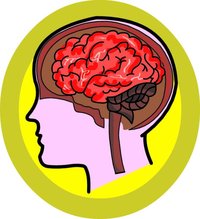Central nervous system
|
|
The vertebrate central nervous system consists of the brain and spinal cord. These lie in the midline of the body and are protected by the skull and vertebrae respectively. This collection of billions of neurons is arguably the most complex object known.
The central nervous system along with the peripheral nervous system comprise a primary division of controls that command all physical activities of a vertebrate. Neurons of the central nervous system affect consciousness and mental activity while spinal extensions of central nervous system neuron pathways affect skeletal muscles and organs in the body.
The peripheral system is composed of the somatic nervous system and the autonomic nervous system, the latter being further divided as the sympathetic nervous system, the parasympathetic nervous system and the enteric nervous system. Each of these interact with various organs, glands or muscles, providing information to and from the central nervous system.
| Contents |
Parts of the central nervous system
See also
External links
- High-Resolution Cytoarchitectural Primate Brain Atlases (http://primate-brain.org)
- Human Brains: A Learning Tool (http://www.marymt.edu/~psychol/brain.html).
- Explaining the human nervous system (http://www.humannervoussystem.info).
- Human and Non-Human Primate Brain Atlases (http://brainmeta.com/brains.php).
Anatomy Clipart and Pictures
- Clip Art (https://classroomclipart.com)
- Anatomy Illustrations (https://classroomclipart.com/clipart/Illustrations/Anatomy.htm)
- Anatomy Clipart (https://classroomclipart.com/clipart/Anatomy.htm)
- Anatomy Animations (http://classroomclipart.com/cgi-bin/kids/imageFolio.cgi?direct=Animations/Anatomy)
| Nervous system |
|
Brain - Spinal cord - Central nervous system - Peripheral nervous system - Somatic nervous system - Autonomic nervous system - Sympathetic nervous system - Parasympathetic nervous system |


